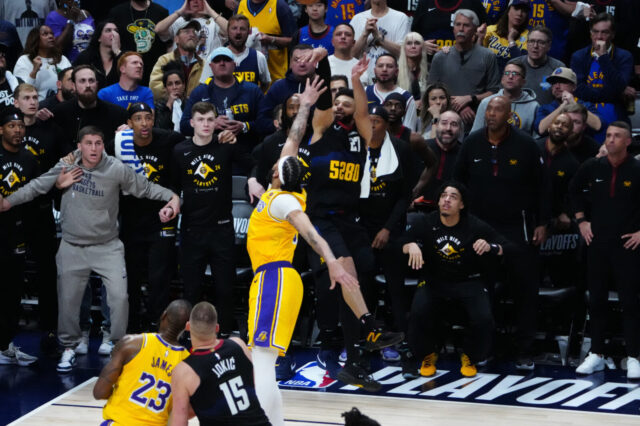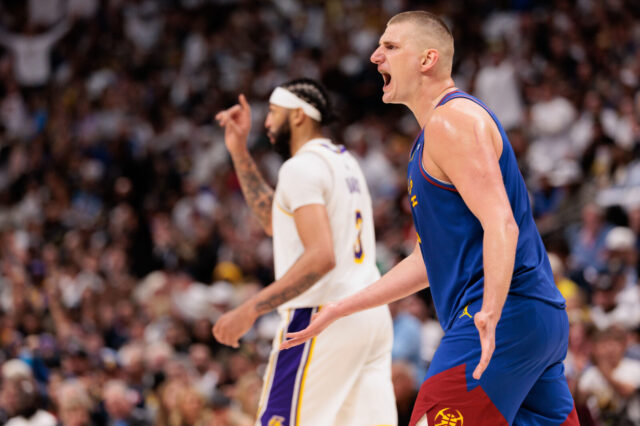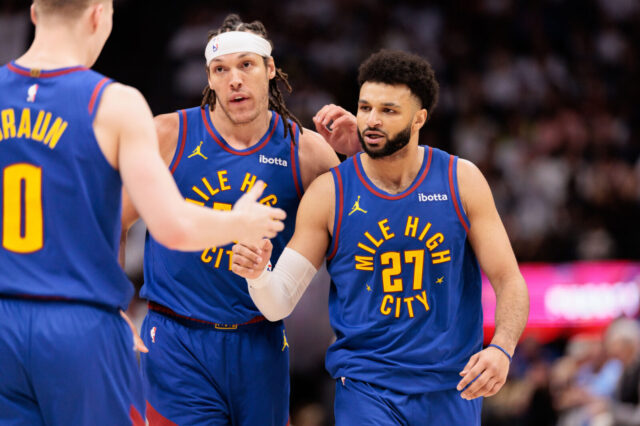When Dallas coach and Dallas National Basketball Coaches Association President Rick Carlisle presented Doug Moe with the organization’s 2018 Chuck Daly Lifetime Achievement Award Sunday, I thought back to an exchange I witnessed between Daly and Moe at McNichols Arena in December 1983.
I was a young — very young — scribe switched to the Nuggets beat after the NHL Colorado Rockies were sold and moved to New Jersey.
That night, before the Pistons faced the Nuggets, Daly was sitting in the press room when Moe stuck his head in.
Daly saw him and said, “First one to 140 wins.”
Moe laughed. “Hell, we won’t even make it through the third quarter,” he responded.
The game lasted through three overtimes. I started and junked about twenty “ledes,” or the first few paragraphs of a story, before finally writing about the Pistons pulling out a 186–184 victory. Kiki Vandeweghe had a game-high 51 points, and Alex English and the Pistons’ Isiah Thomas both had 47. The 370 points shattered the league record of 337, set in another triple-overtime game (San Antonio beat Milwaukee 171–166) in 1982.
It was the last Nuggets game worked by strikebreaker referees before the regulars, who finally had settled with the league, went back to work. If the regular referees had worked it, regardless of what had happened, Moe might not have said what he said when it was over, mostly referring to a missed call near the end of the first overtime: “It was a great game, but we got screwed.”
That’s Doug.
The Big Stiff himself.
Then honor from the coaches’ group recognizes that he truly was innovative and influential. The funny thing is most of them preside over teams that play the conventional clear-out, little-movement-away-from-the-ball game that is such a contrast to Moe’s simple passing game. Pass and move, pass and move, relentlessly. English, Vandeweghe and Dan Issel were the catalysts in my two years, and the trade of Vandeweghe to Portland soon bought in Calvin Natt, Fat Lever and Wayne Cooper.
It also was clear when watching the Sunday news conference feting Moe, many of the media folks in the audience knew little — or nothing — about the man being honored.
I covered his teams for only two seasons, but was around them much more, even during my tenure on the Rockies beat and in later years, after I had moved on to Portland.
The funny thing always was that few truly understood why he didn’t make his North American professional debut as a player until he was 29, in the upstart American Basketball Association, and by then his physical problems so limited him, he provided only a hint of how he would have been an NBA great for a long time if he had joined the league right out of college.
The NBA didn’t let him.
The whole thing was ridiculous.
He was a victim of a 1961 basketball betting scandal. During his senior year at North Carolina and after completing his four seasons of eligibility for the Tar Heels, the scandal broke and Chancellor William Aycock suspended him from school.
Moe was in negotiations with the NBA’s Chicago franchise. But the NBA blackballed him. Over $75. This was a decade after a point-shaving scandal involving thirty-three players and seven schools, which had rocked college basketball, so all were conscious of the potential problem. A gambler named Aaron Wagman met with Moe, the Brooklyn native, in New York in the summer of 1960, offering him money to throw games the next season.
Moe said no. His mistake was accepting $75 in expense money and failing to report the bribe attempt. The meeting had been set up by a UNC teammate.
“I thought I was making a pretty good deal,” Moe once told me. “Here I had turned him down cold. He said, ‘This is for your trip back to school, whatever.’ I said, ‘Sure, great.’ I figured I had turned him down.”
When an ambitious New York district attorney, Frank Hogan, got into the act, Moe’s name was dragged through the mud. Tony Jackson of St. John’s didn’t report a bribe attempt because, he said, he thought it was a joke. He was blackballed, too. Connie Hawkins of Iowa suffered the same fate. The players weren’t indicted. Th e gamblers involved were. None of that prevented Aycock from summoning Moe to his office and telling him that he was tossed out of school.
“He gave me some very good advice,” Moe said. “When something happens to you, you can react to it negatively, accuse people, whatever. He said he was doing his job, that I shouldn’t do anything bad, regardless of how I felt. The papers interviewed me, and I said the chancellor was doing his job, he felt he had to suspend me, that he was right.”
The NBA followed suit. Because Moe and Jackson hadn’t reported the contacts listed in the indictment, the league shunned them.
“It was a very difficult time,” Moe said. “My whole life was basketball. It was hard to adjust. That’s where my personality helped. I screwed up, I was a happy-go-lucky guy, and I guess I didn’t realize that some people round Carolina thought I might have done something.”
Donnie Walsh, later an NBA front office executive with several teams, was Moe’s teammate at North Carolina. “We knew it was all totally B.S.,” he once told me. “We knew Doug, we played with him. I remember when the chancellor threw him out of school. The students marched on his office.”
Moe ended up finishing school at tiny Elon College, and he was shocked—and chalked it up as part of a lesson—that Chancellor Aycock told Elon officials that Moe should be admitted.
“The president of Elon said, ‘What did you do to the chancellor?’” Moe said. “I thought, ‘Oh, —-.’ But then he said, ‘I’ve never got that good of a recommendation from anybody. He was going on and on.’
“You know, earlier it might have been easy to say the chancellor screwed me. When something like that happens, you can look for excuses. When things aren’t working out right for you, instead of blaming someone else, maybe you should look at yourself and find out if it might be partly your fault.”
Moe was at Elon for two years, finishing his degree and serving as assistant coach for the basketball team. After playing four years at North Carolina, he still had much work to do before getting his diploma at Elon. “I used to tell people that Doug was so lazy, that if they were handing out A’s at the administration building, Doug would ask one of us to go over and pick them up for him,” Walsh said.
At Elon, he started taking school more seriously, at least during certain times of year. Moe’s photographic memory impressed a history professor for the first part of a term. But then the professor noted a change and called Moe into his office. Describing the meeting, Moe adopted a prim English accent, “‘Mr. Moe,’ he said to me, ‘you had a Harvard A in my class, but then basketball season started and your interest began to decline.’ I said, ‘If you think it’s that way here, you should have seen me before [at North Carolina].’”
Moe went to Padua, Italy, and played there until the American Basketball Association opened shop in 1967. He was one of the upstart league’s top scorers for five seasons, and he and Hawkins—another ABA star—sued the NBA and settled out of court. “I got to finish school at Elon, and playing in Italy [with Padua] in 1965 and 1966 were the two best years of my life,” Moe said.
Walsh got letters from Moe from Italy. “He used to send us clippings, and the headline would say, ‘El Grandioso Moe,’” Walsh said. “And he was the best. Compare him to Jerry West, Oscar Robertson, all those guys. That was about the same time Bill Bradley went over there, too, and I knew Doug was better than Bradley. That was heresy then. Then the ABA got started.”
Moe said he might not have returned to North America to play in the ABA if his sons, Doug Jr. and David, hadn’t been approaching school age.
“The ABA was great, a lot more fun than the NBA,” he said.
Later, he finally made the NBA. As a coach.
Early during my time on the beat, Lakers coach Pat Riley caused controversy when he announced he was closing practices to the media.
Until then, practices traditionally were open. The NBA office and the NBA Writers Association tried to fight the trend, but it turned out to be spitting into the wind. Moe’s practices remained open, which during the time of a newspaper war in Denver meant that Kevin Simpson of the Rocky Mountain News and I and I had to be at the practices from start to finish, out of self-defense. If something bizarre happened and only one of us was there, the writer present had a huge exclusive and the unfortunate absent scribe might be covering Regis College lacrosse the next week. When we jokingly asked Moe to follow Riley’s lead and close practice, which would have meant that we didn’t need to be there until they were over (as is the custom now, making NBA beat work far less time-intensive than NHL and MLB beat work), Moe’s response was derisive. “If I have to watch this —- , you do, too,” he told us.
At practice one day, he climbed to the top of the Regis Field House bleachers, put a bag over his head—in homage to frustrated fans of the New Orleans “Aints” and to the Gong Show’s “Unknown Comic”—and sat down.
“You better cut a nose hole in that thing,” yelled Issel, “or you’ll suffocate.”
I spent a lot of the time at practices talking with Gus, assistant coach Bill Ficke’s five-year-old golden retriever. Now, NBA coaching staff s seem as large as playing rosters. There are about eleven guys in suits on the Denver bench attempting to look indispensable as they hold clipboards and perhaps tell the television interviewers at halftime that the Nuggets need to hit the boards harder.
During the 1983–84 season, Moe had one assistant coach—Ficke, a former Air Force man who owned an athletic shoe store and was one of Moe’s best friends. (He now is a a well-known restaurateur and the owner of Big Bill’s New York Pizza in Centennial, a magnet for Denver-area sports figures.) Bill knew basketball, but even he admitted he was an unconventional hire. Ficke brought Gus with him to practice, and the dog—the son of a Westminster Kennel Club champion—was well behaved on the sideline. Moe and Ficke were inseparable on the road. Once, they decided they both wanted to lose weight and were going on a chicken-only diet on one extended road trip. One afternoon, I joined them in the hotel coffee shop, where the waitress brought them order after order of baked chicken.
Andre the Giant couldn’t have eaten as much chicken as Doug and Bill that day. On their “diet.”
Much was made of Moe’s verbal assaults on the players, whether during time-outs or even as the game continued, but the point was that he knew who could handle it—and who needed it. He was merciless on Vandeweghe, trying to prod him into abandoning his placid personality and becoming tougher. It was a losing battle, but Moe knew he had to try and got about as much out of Kiki as was possible in the high-paced game. At one point, Moe
confessed that he had a fantasy: that Vandeweghe finally would decide he had heard enough.
“I want him to tell me, ‘[bleep] you!’” Moe told me. “I want him to get mad enough where it hurts him, to where he wants to knock someone’s butt off. He can do it. But it’s just because of his lifestyle, his personality.”
Moe also picked on Glen Gondrezick and Bill Hanzlik, ultimately a Nuggets head coach himself and now a television analyst. The six feet seven guard-forward once got so exasperated with Moe’s tirade during a time-out that he started to yell back. The problem was, he had a mouth full of water, which ended up being sprayed everywhere as he delivered his retort to his coach. Moe got the most out of Hanzlik, though, even using him to guard the Houston Rockets’ seven feet four Ralph Sampson, frustrating Sampson because Hanzlik refused to back down, figuratively or literally.
Moe didn’t get on Issel much and realized that English, the poet off the court, was hypersensitive and screaming at him was counterproductive. Still, despite that relative kid-gloved treatment, English’s relationship with Moe was strained when he left as a free agent in 1990.
On November 22, 1983, the twentieth anniversary of the John F. Kennedy assassination, the Nuggets—who came in with a three-game winning streak—were getting blown out at Portland and the fans in Memorial Coliseum were informed that the Trail Blazers were on the verge of a single-game record for points scored. With 1:12 left, the Blazers had 146 points, four short of the record. The crowd was clamoring. Moe called a twenty-second time-out. Angrily, he told his team that since they hadn’t played any defense all night, there was no sense starting now, and he ordered the Nuggets to not even pretend the rest of the way. They were to stand aside, allow the Blazers to score, and let the fans celebrate the record.
I was sitting near the bench and could hear the exchange during the timeout.
Frankly, I thought it was funny. Portland coach Jack Ramsay, whom I later came to know when I was columnist at The Oregonian and greatly respect (what a terrific man), considered it an affront and glared at Moe as he walked off the court.
After the game, Moe sarcastically explained, “Our defense was getting so tenacious there, I was afraid they weren’t going to get 150. I really was scared.”
Th e Blazers were favored by five and won 156–116, so Moe’s decision didn’t affect any wagers. Yet the NBA’s preoccupation with avoiding any hint of gambling scandal was reflected in its decision to fine Moe $5,000 and suspend him for two games. Moe’s one-time banishment for not reporting the bribe attempt also might have made the league incapable of having a sense of humor about the Portland incident. It was all about image, not reality. The NBA statement was that the “no mas” defense was “contrary to the very essence of sport, which demands a full effort for the entire length of the game.”
The embarrassed Nuggets also had won the next night, beating Bill Walton and the San Diego Clippers. “I knew what I did and why I did it,” Moe said. “In this business, you’re worried about winning games and you keep your job depending on how well you do.”
That was so typical Doug. He defied convention. Mostly, he despised pretension. And he got the most out of his teams. My two years as a beat writer covering him were only a snapshot, of course, and there are hundreds of stories like these from others who covered him before and after.
His honor from the coaches’ group was fitting — and long overdue.
* * *
Terry Frei of the Greeley Tribune writes two commentaries a week for Mile High Sports. He has been named a state’s sports writer of the year seven times, four times in Colorado (including for 2015 and 2016) and three times in Oregon. He’s the author of seven books, including “Third Down and a War to Go” and “’77: Denver, the Broncos, and a Coming of Age.” His web site is terryfrei.com. His Mile High Sports commentary archive and additional “On the Colorado Scene” commentaries are here. His major Greeley Tribune pieces, including his column on Eaglecrest High and UNC grad Andy Kelso, a bona fide Broadway star, can be accessed here.
E-mail: [email protected]
Twitter: @tfrei



